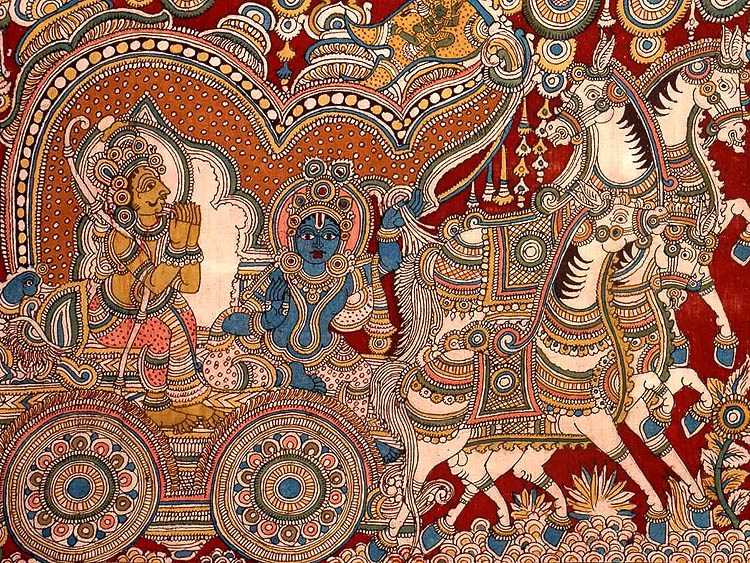Kalamkari literally translates into “pen craft”; with ‘kalam’ meaning pen and ‘kari’ meaning art. It is among the most beautiful traditional Indian art forms and involves block printing or hand printing, typically done on pieces of cotton fabrics. The unique feature of the Kalamkari art is that it makes use of only natural colours or vegetable dyes.
The Origin of Kalamkari Art and Printing
Kalamkari art and printing is concentrated primarily in Andhra Pradesh, particularly in Kalahasti and Machilipatnam, and a few other smaller regions of the state. Srikalahasti was the main center of kalamkari art for a very important reason: it received a constant supply of clean river water. Kalamkari art was the household occupation of several rural women and craftsmen in the ancient times and continues to be passed down from one generation to the next. Andhra Pradesh is still the main hub of kalamkari printing in the country.
Craftsmen engaged in kalamkari art had to later modernize some of the ancient, hindu-mythology inspired kalamkari themes because there was an increasing demand for these prints in the international market. Therefore, Persian art slowly became one of the major influences on the original kalamkari designs.
Different Styles of Kalamkari Art
Kalamkari art is available in two distinct styles: Machilipatnam and Srikalahasti. Both these centres are located in the state of Andhra Pradesh.
I. Kalahasti Kalamkari

Craftsmen practicing the Srikalahasti style of kalamkari art continue to make use of the traditional dyeing technique, inherited from their ancestors. Srikalahasti is a small temple town found in the Chittoor district in Andhra. The main design inspiration for the Srikalahasti style is ‘hindu mythology’.
The Srikalahasti style is characterized by one very important feature: free hand drawing. The procedure begins with the craftsman treating the cotton cloth using mordant and sketching the design outline with black colour or ‘kasami’. The only other colours used for filling the outlined sketch are those obtained from natural plants: indigo, green, red and vibrant yellow. Therefore, every piece of the kalahasti kalamkari art is quite unique and absolutely authentic!
II. Machilipatnam Kalamkari
The Machilipatnam style of kalamkari is different from the kalahasti style because it is not exactly ‘pen craft’. While creating kalamkari art using the Machilipatnam style, the craftsman creates his sketch and its key design features with the help of hand-carved blocks. These blocks continued to be used repeatedly for many years and by different craftsmen.
Kalamkari art is known for its beautiful colour patterns that flow through a variety of different themes. You can often spot figures of women in yellow, demons in green and red and Gods in shades of blue. Lotus motifs tend to be the most common background for these prints.
In the kalamkari printing technique, the craftsman first decides on the fabric and colours. The chosen cloth is then bleached using either cow or goat dung. It is further treated with a milk and myrobalan solution that helps prevent the colour from spreading.
Why Kalamkari is Becoming Increasingly Popular
An increasing number of people all across the globe are now discouraging the use of harmful chemicals in production and manufacturing. In such a scenario, kalamkari emerges as the perfect craft because it avoids the use of artificial chemicals and still produces beautifully coloured fabrics.
Today, women in the country can shop for a range of different kalamkari printed silhouettes including kurtas, sarees and dupattas in gorgeous designs and colours!